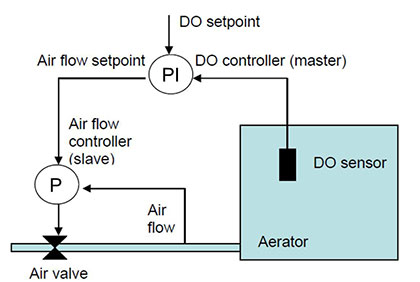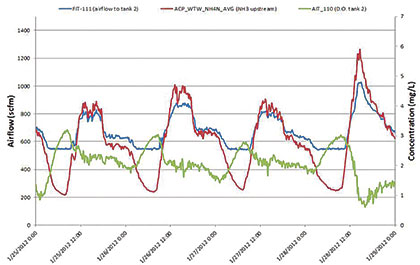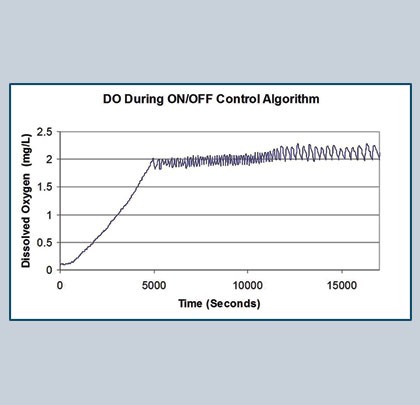Figure 3: On-Off Control Dissolved Oxygen Response (source: Meck, D., R. Odum, N. Wobbrock, Cornell University)
In the final piece of this series, we detail how online instrumentation for control of wastewater treatment aeration provides measurements at a frequency, accuracy, and reliability suitable for process control and illustrate some of the common applications that end-users look for.
ON-OFF CONTROL
The simplest form of feedback control is on-off control. Like sequencing, it is relay-based. However, instead of operation based on a timer, aeration is started and stopped in response to online measurements of response variables. The control variable assumes a maximum (blower on/valve open) when the error is greater than zero and minimum (blower off/valve closed) when the error is less than zero. On-off control is inexpensive and can be easily retrofitted into existing facilities. Only minor control modifications are required, particularly for facilities where separate batteries of blowers are used for each aeration basin in place of a common blower system such that basin air flow control and blower air flow control are the same. The major capital expenses are for mixers to uncouple mixing and aeration. The main drawbacks to on-off control are smooth control is not possible, slow system response, and excessive actuator wear.
Figure 3 illustrates each of these drawbacks. At the beginning of the aeration stage, the oxygen demand of the bacteria is greater than the oxygen supply at the max rate, resulting in a slow rise of DO up to the 2.0 mg/L setpoint. Even when supply does catch up to demand, the rate is such that the on-off cycles are very short and the DO never settles at the setpoint. Towards the end of the aeration stage, the “off” airflow intervals lengthen as a result of decreasing oxygen demand. The “on” airflow aeration stages decrease because even short pulses of air cause a persistent overshoot of the DO setpoint.
A dead zone or hysteresis is typically inserted into an on-off controller to limit wear on the actuators due to starting and stopping. Dead zone defines a range above and below the setpoint where a control action is not taken. The system is “dead” in a defined range above and below the setpoint. Hysteresis is similar except that a range above the setpoint is defined where a control action is not taken.

Figure 4: On-Off Control with Hysteresis
Hysteresis may also be used with a delay timer. The principle is illustrated in figure 4. The actions at each numbered point are as follows:
- Relay open, blower off;
- DO falls below the setpoint starting switching delay timer, t1;
- The switching delay expires, the relay closes, the blower turns on;
- DO rises above the setpoint hysteresis limit, starting switching delay timer, t2.
- Switching delay expires, relay opens, blower shuts off.

Figure 5: Bending Point Diagram (reproduced G. Olsson, M. Nielsen, Z. Yuan, A. Lynggaard-Jensen, J-P Steyer (2005) Science and Technical Report No. 15, Instrumentation, Control, and Automation ©IWA Publishing)
On-off control is most suitable for completely mixed reactors with long hydraulic and solids retention times. On-off control based on DO setpoints can be combined with analysis of bending points in curves from online instrumentation for a more advanced control strategy. An inflection point in the pH and ORP curves shown in figure 5 indicates when ammonia is depleted and the air can be shut off. Similarly, the strategy can also be extended for denitrification using ORP or nitrate. The so-called “nitrate knee” indicates when nitrate is depleted and air should be turned on.
PID CONTROL
Greater aeration efficiency requires a proportional integral-derivative or PID controller to more closely match the air supply to the oxygen demand. The PID controller has been around for decades and is far and away the most common controller used in the process industries. It gets its name from the three actions it applies: proportional action, integral action, and derivative action. The proportional term provides a control signal in proportion to the magnitude of the error. Proportional control of DO is unstable if the gain is set too high. DO is driven towards the setpoint at a high rate initially, causing overshoot. Overshoot occurs again on the return and becomes less and less as the system oscillates above and below the setpoint and hunts for a stable condition. If another disturbance occurs before the system stabilizes the hunting continues. The integral term provides a signal proportional to the duration of the error. With a PI controller the gain can be set lower and the I term ensures the setpoint is reached. Derivative action is proportional to the rate of change of the error. In theory, this could be used at facilities where sudden and substantial changes in load occur on account of storm events or industrial discharges. In practice, derivative action is rarely utilized.
DIRECT CONTROL BASED ON DO
The simplest method for PID feedback control of DO is direct adjustment of the air supply rate based on the DO measurement. However, this strategy has limited applicability due to the nonlinear relationship between air flow and DO. Therefore, direct control is most suitable for use with mechanical aeration systems or diffused aeration systems in which each aeration basin has a dedicated air supply.

Figure 6: Dissolved Oxygen Cascade Control Diagram (source: Gustaf Olsson, Lund University, Sweden)
CASCADE CONTROL BASED ON DO
The standard configuration for a DO control system utilizing PID control is a cascaded control system shown in figure 6. The DO controller, typically a PI controller, calculates the airflow required based on the difference between the input DO setpoint and DO sensor measurement. The output from the DO controller is the setpoint for the airflow controller (the slave) which compares the airflow setpoint with the actual airflow and adjusts the basin or zone air flow valve accordingly. A P controller is recommended for air flow, allowing the DO controller to correct any errors in the airflow. A PI–PI controller will be less stable because the two controllers will work against one another. Of course, pressure in the main air header will increase or decrease in response to changing air flow demand. The non-linear relationship between air flow and DO concentration and the lag time to reach equilibrium in response to changing air flow results in setpoint overshoot causing repeated adjustment of control valves and actuators. Therefore, a second control loop is required to adjust the blower air flow in response to the pressure in the main air header. The most open valve (MOV) control strategy attempts to optimize blower and valve adjustments by ensuring that the valve serving the zone or basin with the highest air demand is full open.
DIRECT CONTROL /AMMONIUM
The ideal response variable for facilities required to remove ammonia-nitrogen is, of course, ammonia. Nitrification is the rate-limiting step which means that complete nitrification assures that BOD is also removed. Two methods of feedback control with online ammonium sensors are practiced. The direct method uses the ammonium sensor in place of the DO sensor in a cascade arrangement. The problem with this strategy is that DO responds much faster than the ammonium concentration. Consequently, DO fluctuates as the ammonium controller adjusts the airflow setpoint. Typically, a DO sensor is also installed as a constraint to limit air flow above a defined DO concentration. This prevents overaeration but is a troublesome tuning problem.
CASCADE CONTROL /AMMONIUM
A more desirable strategy is to add the ammonium controller on top of the DO controller in a cascade arrangement. In the cascade strategy, the ammonium controller, typically a PI controller, sets the DO setpoint based on the ammonium concentration and the DO controller calculates the airflow requirement as in the standard configuration. For example, a DO of 2.0 mg/L when ammonium is greater than a certain concentration to speed up the reaction and a lower DO to reduce aeration energy usage when ammonium is nearly depleted. A critical aspect of this strategy is the selection of sampling times. The ammonium control loop has to be much slower than the DO control loop for the control system to work properly.
BARRIERS TO FEEDBACK CONTROL
Feedback control is not yet widely utilized for wastewater aeration control in North America for various reasons including understanding of the process, cost, complexity, and incentive. What isn’t understood can’t be controlled. Fortunately, the understanding of the dynamics of nutrient removal has improved substantially in recent years and the accumulated knowledge is built-in to easily accessible wastewater simulators. With understanding, the aeration system, including the controls, can be designed appropriately.
Additional costs are required to purchase sensors and control equipment, obviously. However, the greatest cost is the cost of upgrading the air supply and distribution system. A control system can’t function without suitable control elements. Basin air valves need to be motorized, positive displacement blowers require VFDs, and centrifugal blowers require inlet throttling, at least. Blower replacement may be needed to achieve the highest efficiency. The workhorse for decades has been the multi-stage centrifugal blower. These machines have limited turndown capability and their efficiency declines significantly with inlet vane throttling. Furthermore, blowers remain in service for decades. Back when they were originally installed coarse bubble diffusers were the standard. Fine bubble diffusers which provide much higher oxygen transfer efficiency are now the standard but require higher discharge pressures. Consequently, the blowers operate further out on their system curve than the original design limiting the available operating range. Reconfiguration of the air distribution system in the aeration tanks may also be required to supply the required aeration density.
Feedback control requires instruments, controllers, and actuators. A malfunction of any one of the three components will result in an inadequate response. Proper maintenance of the instruments is crucial. Therefore, training is very important to achieve operator buy-in and commitment. In many cases, online instrumentation is simple to maintain. The most important task is verification of the measurements at regular intervals or when readings do not match expectations. Handheld instruments or sampling and analysis in the lab using a colorimeter provide quick and inexpensive methods for this purpose. Even without a malfunction, a control system will perform poorly if not properly tuned. The perception is that feedback control is complex and requires hiring consultants, integrators, and electricians. However, there are systems today that do not require advanced engineering. In addition, autotuners are available to simplify the tuning procedure.
It is also significant that utilities have not had sufficient incentive to implement automation. Rising energy costs and resistance to increasing operating budgets will overcome this barrier. In Europe, for example, where energy costs are higher, DO control is much more common
FEED FORWARD CONTROL
Feed forward control involves measurement of the load (disturbance) and adjustment of blowers and valves based on the predicted response. Calculation of the load requires measurement of wastewater flow and ammonium, if nitrification is required, or COD if nitrification is not required. A reasonably accurate model is also required to calculate the predicted oxygen demand and aeration rate. Feed forward control is superior to feedback control for responding to peak loading situations and, as a result, has the potential to produce higher quality effluent more consistently. The feed forward aeration control system used at Wheaton (Illinois) Sanitary District consists of a PLC that calculates the required air flow based on a number of factors, including upstream ammonium concentration from online sensors, and adjusts air flow accordingly. When the measured ammonium is below a threshold concentration, the control system maintains a minimum airflow for mixing.

Figure 7: Feed Forward Control (source: Poole, et al)
Figure 7 demonstrates the capability of feed forward control to keep up with oxygen demand, even during peak periods. The system used an average of 3,666 standard cubic feet per minute (scfm) of air (1.14 scfm/lb BOD treated). Energy savings compared with no control was calculated to be 11 percent compared with DO feedback control. However, feed forward control without feedback is usually not recommended. Feedback control will compensate for inaccuracy caused by the feed forward control. Feedback loops are also typically incorporated to account for errors in the predicted response increasing the complexity and cost of implementation.
AERATION CONTROL COST-BENEFIT
It has been estimated that DO control systems reduce energy consumption compared to manual control by 50 to 100 kWh per million gallons treated. Implementation of DO control at the Sheboygan, Wisconsin, WWTP reduced energy consumption by an estimated 459,000 kWh, approximately 105 kWh per million gallons treated. The estimated cost savings was $65,000 annually resulting in a simple payback of less than two years. Interestingly, the DO control component was not part of the original project which included new blowers. It was only added in after operators were unable to control wide fluctuations in DO. The new control system more than do bled the energy savings for a much smaller investment.
The J.D. Phillips Water Reclamation Facility in Colorado Springs, Colorado, implemented ammonium-based aeration control to minimize aeration energy for nitrification. A brief trial period demonstrated that an estimated annual energy savings of $50,000 could be achieved by simply reducing the DO setpoint during daily low flow periods.
The above examples aside, evaluation of cost-benefit for aeration control projects is not straightforward. Energy savings as a result of a control project are not typically reported, if the accounting is even performed. One important reason is that assigning costs and benefits is challenging. Wastewater treatment plants are complex and so are the improvement projects that include control components. Multiple improvements are usually bundled together, for example switching to another form of aeration or replacing diffusers or blowers. It is no easier to assign benefits. Utilities do not keep track of expenses at the process or system level. For example, electric submetering of equipment is not typical. Nevertheless, it makes sense that aeration control saves energy and reduces operating costs. The strong and growing interest in aeration control projects is evidence that utilities see the value in aeration control. Simple examples shown in the sidebar demonstrate energy and cost savings potential.
SUMMARY
Instrumentation, control and automation (ICA) is becoming a basic requirement because the “Sneakernet” is simply not practical for efficiently meeting increasingly stringent treatment requirements. For example, strict control of DO is required in order to create the conditions necessary to achieve biological removal of nitrogen and phosphorus. Fortunately, technological advances have enabled design and operation of the aeration system to match the process oxygen demand, improving process performance and reducing energy consumption. Modern online instruments are capable of measurements at a frequency, accuracy, and reliability suitable for feedback or even feed forward control of aeration. The best strategy for a facility must take into consideration several factors including the characteristics of the wastewater, discharge limits, and the treatment process.
However, cascade control of aeration based on measurement of DO and ammonium and implemented through a PID controller offers the greatest potential for energy efficiency and process performance. Implementation of PID control at a wastewater facility will require outside technical expertise and investment in instrumentation and control systems, of course. However, the greatest barrier is typically the cost of replacing blowers, valves, and air distribution systems to match the capability of the control system.
YSI’s environmental products provide high quality, high resolution data to better understand and manage our water resources. They are used for wastewater process control, climate change and drought studies, flood monitoring and warning, stormwater runoff monitoring, groundwater quantification and contamination, aquaculture production, and source water safety. For more information, visit www.ysi.com.
____________________________________________
MODERN PUMPING TODAY, January 2018
Did you enjoy this article?
Subscribe to the FREE Digital Edition of Modern Pumping Today Magazine!
![]()


